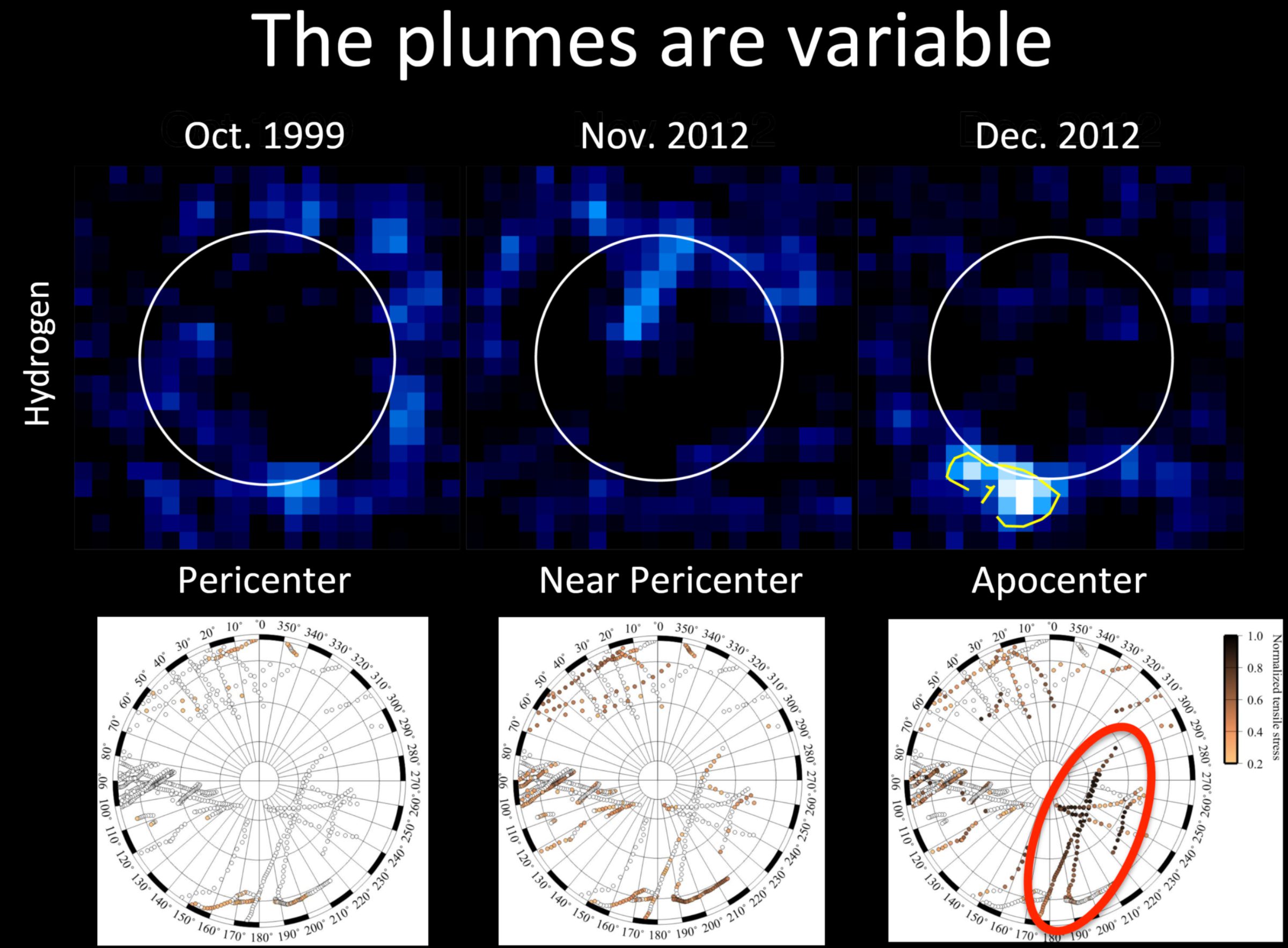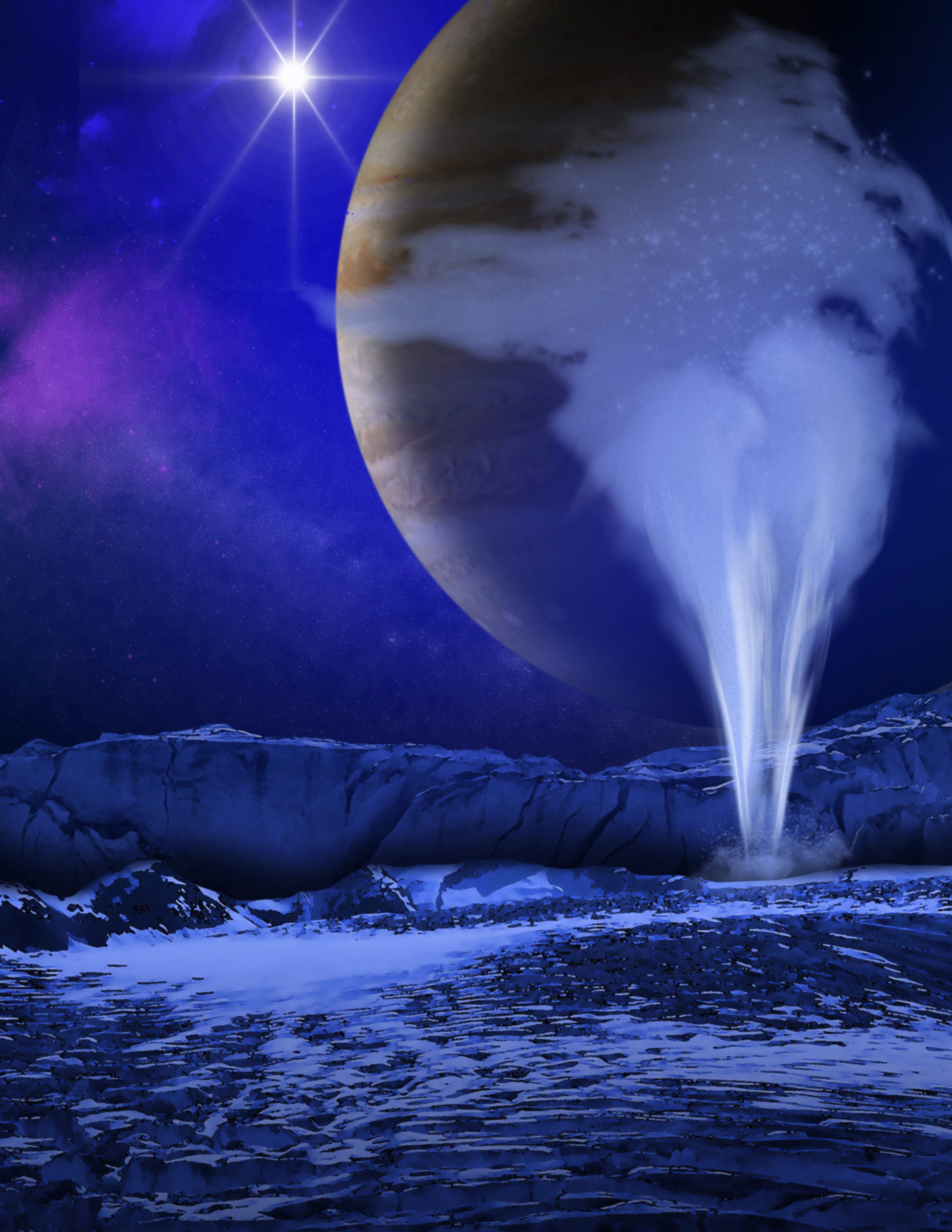Leigh Fletcher • Dec 12, 2013
The Plumes of Europa
Editor's note: This post originally appeared on Leigh Fletcher's personal blog and was reposted here with his permission. --ESL
2013 has been a rather exciting year for Europa scientists, even without a spacecraft anywhere near the jovian system. We've seen evidence of the salty composition of Europa's oceans; models explaining the deep ocean flow and influence on surface features; evidence of surface phyllosilicates from a cometary or asteroidal impact, and today's exciting news: the Hubble Space Telescope discovery of water vapor plumes from the south pole of this icy moon.
Hubble's Plumes
The ultraviolet observations by the Hubble Space Telescope are reported in Science (Roth L., J. Saur, K. D. Retherford, D. F. Strobel, P. D. Feldman, M. A. McGrath, F. Nimmo, "Transient Water Vapor at Europa's South Pole," Science, 12 Dec 2013), and suggest water vapor plumes being dissociated by electron bombardment into their constituent atoms. The atoms reveal themselves to Hubble through ultraviolet hydrogen emission (Lyman alpha, at a wavelength of 121.6 nanometers) and oxygen emission (130.4 and 135.6 nanometers). The excess emission rises 200 kilometers from Europa's south pole, reminiscent of the icy geysers of Enceladus in the Saturn system, with incredible implications for our ability to probe the potentially-habitable conditions on this small satellite. [Enceladus' plumes are taller, about 500 kilometers; Enceladus' surface gravity is significantly less than Europa's. They also reported that an estimated 7000 kilograms per second of material are coming out of these plumes, compared with only 200 kilograms per second for Enceladus. --ESL]
But it's important to note that we've only seen this once, in December 2012, when Europa was at apocenter (its furthest point from Jupiter), so it'll be extremely important to follow this up with future observations. Thankfully, the team is led by researchers at the Southwest Research Institute (SwRI) in San Antonio, Texas, who happen to be the brains behind the Ultraviolet Spectrograph (UVS, on which I'm very lucky to be a science co-investigator) on ESA's Jupiter Icy Moons Explorer (JUICE). The results are being presented at the AGU meeting in San Francisco on Thursday (Roth et al.) and Friday (Retherford et al.), and were subject of a press conference earlier today.

P42A-01. HST Observations of Europa's UV Aurora Morphology
Lorenz Roth; Joachim Saur; Kurt D. Retherford; Darrell F. Strobel; Paul D. Feldman; Melissa A. McGrath; Francis Nimmo
P53A-1838. Discovery of Europa's Water Vapor Plumes: Europa's Atmosphere and Aurora: Recent Advances from HST-STIS and Plans for Plume Searches with JUICE-UVS
Kurt D. Retherford; Randy Gladstone; Lorenz Roth; Melissa A. McGrath; Joachim Saur; Paul D. Feldman; Andrew J. Steffl; Darrell F. Strobel; Thomas K. Greathouse; John R. Spencer; Fran Bagenal; Leigh N. Fletcher; John S. Eterno
Europa's Sub-Surface Ocean
But first back to enigmatic Europa, the smallest and smoothest of the four Galilean satellites (Io, Europa, Ganymede and Callisto) at 3128 kilometers across, so roughly a quarter of the size of the Earth. What makes Europa so intriguing is the suggestion of a global sub-surface ocean, beneath an icy crust somewhere between 10 and 100 kilometers thick, depending on the model you consider. The ocean is kept liquid by the energy released by powerful tidal forces raised by Europa's 3.5-day orbit around Jupiter. What's more, that ocean is thought to be in direct contact with the rocky silicate mantle, and with the surface ices, meaning that all the necessary ingredients for habitability (a source of energy, water as a chemical solvent, as well as a source of elements and minerals) come together in this fascinating environment.
Europa's icy surface is fractured, cracked and in some places "geologically young", meaning that there are few craters because of some sort of resurfacing processes at work. As Europa is tidally locked, with one side continually facing Jupiter, it exhibits stark differences between the leading (forward-orbit-facing) and trailing hemispheres, with the latter being more bombarded by the materials being swept around by Jupiter's powerful magnetic field. And the Galileo spacecraft discovered a weak 'induced' magnetic field, caused by the interaction of Jupiter's magnetosphere with a highly-conductive layer beneath the crust, most likely the liquid ocean. For all these reasons and more, Europa has long been the top destination for a future mission to the outer solar system.

But how might we probe this potentially-habitable sub-surface ocean? Cryobots that melt their way down to the dark oceans remain in the realms of science fiction for now, so we're left with whatever observations can be done remotely. 2013 has seen plenty of new evidence come to light that we can probe the interior by careful observation of the surface and external environment. The first was a paper in the Astronomical Journal in April by Mike Brown and Kevin Hand that used the Keck Observatory to detect magnesium sulphates (potentially epsomite) on Europa's trailing side. They hypothesised that salty ocean brines containing sodium, potassium and magnesium chlorides are somehow delivered to the icy surface (by some geologically active process), where they are bombarded from behind by sulfur being emitted by its neighbour Io to form sulfates (the sulfur being whacked into the trailing hemisphere of Europa by the rotation of the magnetosphere). Most of the sodium and potassium are sputtered (i.e., knocked off the surface) to create a thin atmosphere (e.g., Brown 2001), leaving behind the magnesium sulfates as the product of radiolysis occurring on the ocean brines. So that means we can get a good idea of what the interior ocean is like by looking at the chemistry of the surface materials.

The second result came from theoretical modelling of Krista Soderlund and colleagues in early December ("Ocean-driven heating of Europa’s icy shell at low latitudes") in Nature Geoscience. These authors used ocean dynamics simulations to try to understand the chaotic terrain that covers approximately 40% of Europa's surface and is more common at the equator than at the poles. The jumbled, criss-cross patterns could be caused by thinner regions melting and refreezing, or by solid-state convection within the ice shell. The new models suggest that turbulent convective motions within the global ocean serves to focus Europa's internal heat at lower latitudes, making the ice thinner there. The oceanic model suggests three zonal jets and two Hadley-like circulation cells. Once again, the properties of the sub-surface ocean can be inferred by 'reading' the surface features, and I particularly like how this paper bridged the gap between oceanic circulation models and the features of the ice shell.
But both of these results rely on indirect remote observations - either 'reading' the geology, or conducting infrared spectroscopy to measure the composition. They still don't allow us to directly probe that deep ocean. Until now. The Europa plumes revealed by Lorenz Roth's paper ("Transient Water Vapor at Europa's South Pole") in Science offer the tantalising prospect of directly sampling the chemical composition of material spewed out of the global ocean by some future mass spectrometer. Now, we don't know for sure that these plumes have a water source in the sub-surface ocean, and Hubble only has one plume detection so far, in December 2012. The plumes appear highly variable, and were not spotted when Europa was closer to pericenter in November 2012 (i.e., at the closest point to Jupiter), which suggests that changing stresses along the cracks can open fissures when the moon is 'unsquished' at apocentre, as it was in December 2012 for the full seven hours of Roth's Hubble observations. This variability mirrors the processes governing Enceladus' plumes. Galileo didn't really cover the poles during its 11 passes of Europa, so it doesn't really help us here. But it looks like we have two great examples of icy moon plumes in our solar system (Europa and Enceladus), but we're basing all this on one observation, and we really must go back for more!
A Tantalising Prospect for JUICE
The plume discovery makes the ultraviolet observations from ESA's Jupiter Icy Moons Explorer (JUICE) even more tantalizing. The JUICE mission is currently in the planning and definition phase, but it is envisaged that it will make two close flybys over Europa's chaos terrains in February 2031, reaching within 1000 kilometers of the surface. These chaos terrains will be targeted as the potentially active and thinner crust offers our best opportunities to map the ice-ocean interface. JUICE will be using radar to sound through the ice, laser altimetry to map the topography, magnetic field measurements to measure the ocean conduction, and a range of remote sensing to understand the composition, chemistry and physical properties of the icy surface. The UVS observations envisaged by the SwRI team responsible for the plume discovery now take on a great deal more importance: UVS will conduct detailed plume searches via stellar occultations and far-UV imaging scans of auroral emission (driven by interactions of Europa's plasma with the magnetosphere). Limb imaging will be performed within the several hours of the closest approach to Europa (less than 1000 kilometers above the icy surface), supplemented by stellar occultations at relatively large distances from the moon. A movie of the proposed flyby is shown below, and although it's still 18 years away, these data will be worth the wait! [PS. That also means that the graduates who'll be working on these data are probably in nursery today...].
Flyby of Jupiter's moon Europa by the JUICE spacecraft in 2031 Movie showing the European Space Agency's JUICE (Jupiter Icy Moon Explorer) spacecraft flying past Jupiter's icy moon Europa in 2013. The design of the spacecraft has not been finalized so this is just a mock-up featuring some of the parts of the spacecraft.Video: Video courtesy of C. Arridge, UCL, created for the Royal Society Ice Worlds Exhibit 2013
More Reading:
Flow of an alien ocean, Jason Goodman, Nature Geoscience (2013)
Ocean-driven heating of Europa’s icy shell at low latitudes, K. M. Soderlund et al., Nature Geoscience (2013)
Tilting at Europa, Emily Lakdawalla, Nature Geoscience 6, 899 (2013)
Jupiter's Icy Moon: Window Into Europa's Ocean Lies Right at the Surface, Science Daily
Salts and Radiation Products on the Surface of Europa, Brown and Hand, 2013.
Europa’s Underground Ocean Surfaces, Phil Plait (Bad Astronomy)
Jupiter Icy Moons Explorer (JUICE): An ESA Mission to Orbit Ganymede and to Characterise the Jupiter System, Grasset et al., Planetary and Space Science
Transient Water Vapor at Europa's South Pole, Science, (2013)
Let’s Go Beyond The Horizon
Every success in space exploration is the result of the community of space enthusiasts, like you, who believe it is important. You can help usher in the next great era of space exploration with your gift today.
Donate Today

 Explore Worlds
Explore Worlds Find Life
Find Life Defend Earth
Defend Earth


